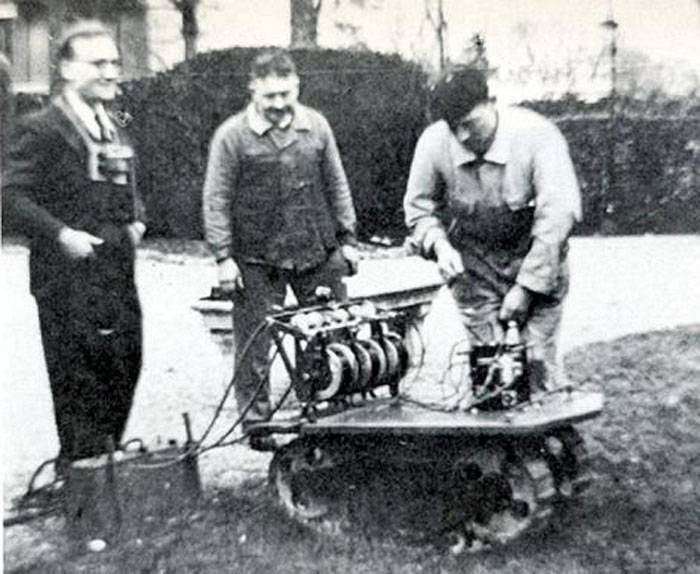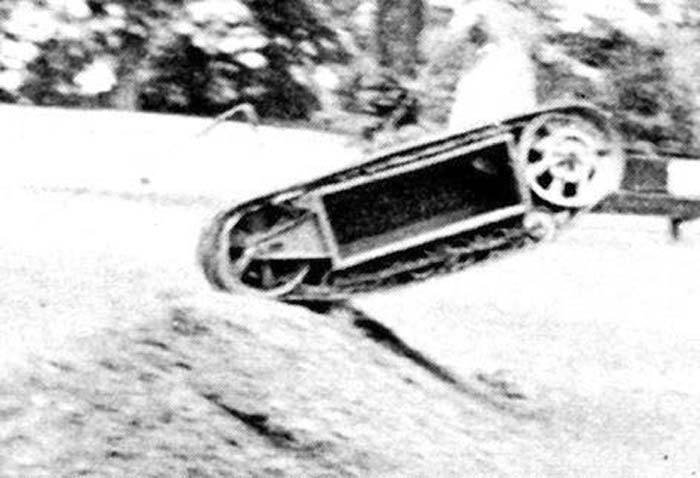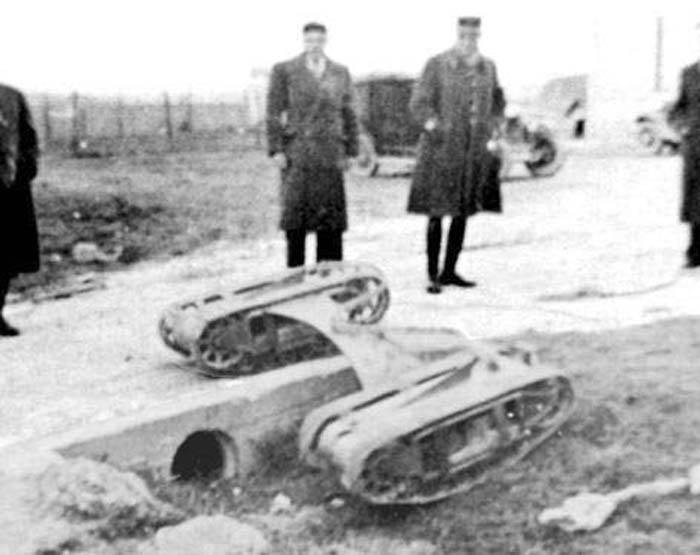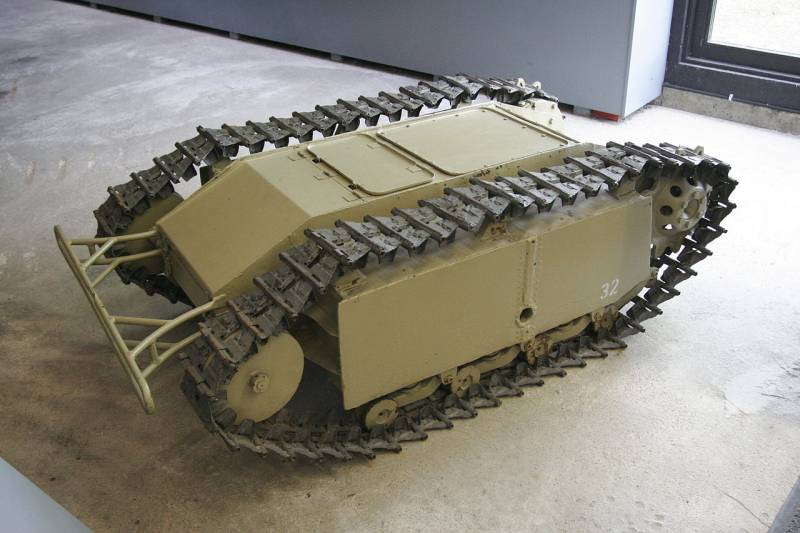Land torpedo Véhicule Kégresse (France)
Project J. Pommelle proposed the construction of a small-sized self-propelled machine with a radio control that carries a subversive charge. Such a self-propelled ammunition could with a certain secrecy approach the obstacles or fortifications of the enemy and destroy them with a powerful explosion. The first tests carried out already in 1939 year, showed insufficient perfection of the proposed sample. However, after some modifications, such a torpedo was put into a series and recommended for use by the engineering troops.
At the end of the same year, the second land torpedo project was launched. It can be assumed that its authors learned about the success of the Véhicule Pommellet product and decided to offer the military department their own version of this technology in the hope of receiving a new order. Looking ahead, it should be noted that the new project was never brought to mass production due to certain objective reasons. Nevertheless, he managed to exert some influence on the further development of military equipment and to become the basis for a whole family of new developments of his class.

Tests of the first prototype. Photo Modelarchives.free.fr
The author of the second pre-war land torpedo project was the famous designer Adolf Kegres, who at that time was working in one of the car manufacturing enterprises. In the interwar period, he was engaged in various projects in the field of automotive equipment for various purposes and proposed several interesting solutions. At the very end of the thirties, a French specialist decided to help progress in the field of remotely controlled combat vehicles, namely self-propelled demolition charges.
The project of A. Kegres, proposed a couple of years later of a similar development by J. Pommellet, received a similar name. This land torpedo remained in stories under the designation Véhicule Kégresse ("Kegres machine") or Véhicule K. In addition, the name Engine K is also known, which also kept a veil of secrecy.
The existing project proposed the construction of a torpedo, externally and in its design reminiscent of the chassis of existing military vehicles. A. Kegress developed a different look, which allowed to obtain minimal dimensions with the most efficient use of available volumes. Moreover, in its design, the new torpedo was to some extent reminiscent of Tanks outdated models. In addition, the designer suggested using an electric power plant instead of an internal combustion engine. Power supply and control of the machine had to be carried out using appropriate cables.
The main element of the new land torpedo was the hull of the required shape. It was a rectangular unit with rounded frontal and aft parts. In addition, the hull received box-sided devices that increased the available volume and served as the basis for the installation of chassis parts. The body should be made of sheet metal; reservation was not provided. A recognizable feature of the Véhicule K is the large caterpillars that completely cover the hull side units.
Inside the hull, in its rear part, it was proposed to mount a pair of electric motors of sufficient power. They are connected to the drive wheels with the help of the transmission as simple as possible. Among other things, it simplified machine control. So, for maneuvering, it was necessary to change the thrust of the engines, adjusting the parameters of the incoming current. The entrance to the turn was carried out in a tank, due to the difference in speed.
A. Kergess proposed a very simple undercarriage design. In front of the hull, directly in front of the onboard unit, it was necessary to install a pair of large diameter guide wheels. They were slightly raised above the ground, curving the track for more convenient climbing on obstacles. In the stern of the drive wheels located the same size, raised above the ground. Due to the need to mount the transmission, the drive wheels were installed using external triangular supports.
Under the onboard devices of the hull, six small-diameter support rollers were mounted on a rigid suspension. The rollers were interlocked using several small longitudinal beams. The front pair of rollers protruded slightly before the frontal wall of the onboard unit. The rear rollers had a similar design and also protected the corner of the hull. Separate support rollers were missing. The upper branch of the small caterpillar was supposed to lie directly on the roof of the hull.

Later prototype on tests. Photo Aviarmor.net
In the case it was planned to install a coil for transporting and issuing cables responsible for powering the engines and controlling the machine. According to reports, A. Kegress was far from immediately able to find the optimal layout that provides the most convenient placement of the cable and reduces the risk of its breakage. Because of this, some prototypes differed in the external location of the coil.
To solve these problems, it was proposed to use three wires that perform different functions. At the same time, early prototypes could have separate wires on their own coils, while the series was supposed to be equipped with ground torpedoes with a single cable having the required number of cores. In the later stages of the project, it was possible to develop and fit into the case a coil containing 1500 m of wire.
Control was to be carried out using a separate operator console connected to the current source. As the Véhicule Kégresse project evolved, these products were refined several times. In particular, the control panel has come a long way from a simple device with several main components to a more sophisticated product, corresponding to the characteristics of military operation.
In front of the land torpedo's hull a high-explosive charge was to be placed. In the existing volume it was possible to place up to 60 kg of explosive. It was planned to control the warhead with an electric fuse, initiated by the operator from the console. The existing warhead allowed the destruction of non-explosive barriers of various configurations, as well as inflicting the most serious damage to structures not distinguished by a high level of protection.
One of the objectives of the Véhicule K project was to reduce the size and combat weight while ensuring high technical and combat performance. In general, it was successfully resolved. The land torpedo in full combat configuration had a length of 1,5 m with a width of 850 mm and a height of only 560 mm. Combat weight was 200 kg, of which 60 kg accounted for the explosive charge. The maximum speed of the car on a good road was to reach 8-10 km / h. The power reserve was limited only by the generator, but the cable length reduced the combat radius to 1,5 km.
At the very beginning of 1940, Adolf Kegres, with the assistance of his colleagues, built the first prototype of a future land torpedo. For several reasons, this product is very seriously different from the subsequent machines. For example, it had to be equipped with other means of installation of the guides and driving wheels, made in the form of vertical supports. In addition, a large rectangular platform appeared on the body of reduced width, above the upper branch of the caterpillars.
Due to the need to test new ideas and refine some technical solutions, some of the controls were moved outside the hull. For this reason, a support for three separate coils, each of which had to carry its own wire, appeared on the aft of the upper platform. Separate cables were connected to the control panel, made in the form of a compact portable device. In this form, the prototype could show its advantages and disadvantages, but it was not suitable for use in the armed forces.

Kepress torpedoes, connected by a crossbeam. Photo Aviarmor.net
The site for the first prototype of the Véhicule Kégresse was the designer’s own yard. At this site, it was possible to verify the operation of the main units and study the behavior of the wired control system. After receiving positive results, it became possible to build a full-fledged prototype corresponding to the proposed combat configuration. It differed from the first car by a wider body and also by the absence of the upper platform. All the necessary devices are now placed inside a closed case. Also, some other details have undergone certain refinements.
In the spring of 1940, new prototypes of the land torpedo Véhicule K were presented for military tests, the results of which were supposed to decide on the future fate of the project. It was found that the existing power plant provides sufficiently high mobility characteristics, allowing the machine to move on different surfaces and overcome obstacles. Despite the small size and limitations associated with them, the device showed good throughput. The 60-kg warhead could successfully fight various targets.
First of all, during the tests, the mobility of the self-propelled demolition charge was checked. At the same time, from a certain time, A. Kegress and the military began to explore new options for applying such weapons in one configuration or another or role. So, it is known to conduct experiments on the joint use of two torpedoes, connected with each other by a transverse beam. Such a complex, apparently, was intended for the simultaneous delivery of two warheads or other payloads to the target.
During the field tests, the torpedo Véhicule Kégresse quickly showed high performance and confirmed the possibility of successfully solving the assigned combat missions. All this led to the emergence of an appropriate decision of the command. Not later than the beginning of the summer of 1940, before the completion of the full test cycle, the military leaders decided to adopt the torpedo. According to some data, an order for mass production of such products soon appeared. The details of the signed agreement are unknown, but some sources claim that the French army wanted to acquire 12 thousand self-propelled demolition charges.
It can be assumed that the mass production of prospective weapons should have begun at one of the French enterprises immediately after the completion of the tests. Probably, Véhicule Kégresse products were to be produced and operated in conjunction with the larger and heavier land torpedoes Véhicule Pommellet, which have already been ordered in quantities of 2 thousand.
The first serial torpedoes of A. Kegres' design could appear in the very near future, but the army did not wait for such weapons. 10 May Hitlerite Germany attacked France. Land torpedo tests were still ongoing, and there was no possibility to launch mass production. As a result, by the time of surrender, the required work had not been completed. The industry has not collected a single serial machine Véhicule K.
Not wanting to give their groundwork to the enemy, the French specialists got rid of the available prototypes in one way or another. So, one of the torpedoes was flooded in the Seine. Probably, was destroyed, and at least part of the design documentation. However, this did not help. Already in July, 1940, the German troops found the submerged land torpedo and soon restored it.
An unusual sample of military equipment was carefully studied on the spot. The invaders became interested in the French torpedo and determined its further fate. The prototype found was sent to the Borgward enterprise, while working on the issue of creating equipment with remote control. German engineers studied and experienced the trophy and made the necessary conclusions. In addition, they determined which ideas and decisions of A. Kegress should be adopted and used in their own projects.

German mine Sd.Kfz.302 Goliath, created taking into account the French developments. Photo of Wikimedia Commons
It is obvious that the study of the French land torpedo had a positive impact on the development of German projects of similar technology. Already in the spring of 1942, Borgvard launched the production of Sd.Kfz self-propelled mines. 302 Goliath designed to attack enemy tanks or stationary ground targets. The newest German weapons in their appearance, architecture and design resembled the French torpedo, which directly spoke of borrowing certain ideas. Subsequently, German engineers improved the Goliath self-propelled mine, as a result of which it received an internal combustion engine, an improved running gear, etc.
The French-made Véhicule Kégresse project stopped at the ground test stage and was actually closed due to the threat of a promising weapon in the hands of the enemy. However, one of the prototypes could not be hidden even at the bottom of the river, and it nevertheless became a trophy. However, this development of events led to the fact that the technical solutions of A. Kegress, even if in a seriously revised form, were brought to serial production and operation.
Before the occupation, France did not have time to build a single serial land torpedo of the Adolf Kegres design, which is why one can only guess what the real results of the exploitation of such weapons would be. However, a solidly revised version of such a product was later adopted by the Wehrmacht and was very actively used in battles. After studying the features of the operation of the German product Goliath, you can roughly imagine the prospects of the French project.
It is well known that German mines of the Goliath family were produced in sufficiently large quantities: before the end of the war Germany had time to release more than 7,5 thousand such products. However, serial mines differed in high cost and great complexity of exploitation. In addition, such weapons were considered not the most successful because of the presence of a number of characteristic problems. Thin anti-bullet armor did not always provide the desired protection, the tracked undercarriage did not allow for high cross-country maneuverability, and the control cable was not distinguished by high survivability. As a result, the overall effectiveness of the use of self-propelled mines left much to be desired, although if used correctly, they could become a significant influence on the course of the battle.
A number of common features of the French land torpedoes and the German self-propelled mine, caused by the most direct link of the projects, suggest that the Véhicule Kégresse product in terms of operation would be similar to the later Sd.Kfz. 302 Goliath. This means that the torpedo would be very expensive to manufacture and only limited to be suitable for solving combat missions. In this case, there would be a certain probability of losing the torpedo from enemy fire or accidental fragments.
However, it was not possible to test the actual capabilities of the Véhicule K in practice. In connection with the end of the fighting and the beginning of the occupation, all the work on this project stopped. Further development of the original ideas was carried out by German designers, and even led to certain results. Nevertheless, the initial project of A. Kegress was closed due to the lack of real prospects. Another attempt by France to create its own land torpedo did not lead to the expected results.
Based on:
http://modelarchives.free.fr/
https://aviarmor.net/
http://warspot.ru/
http://ww2f.com/
Everett HR Toscano M. Unmanned Systems of World Wars I and II. MIT Press. 2015.
Information